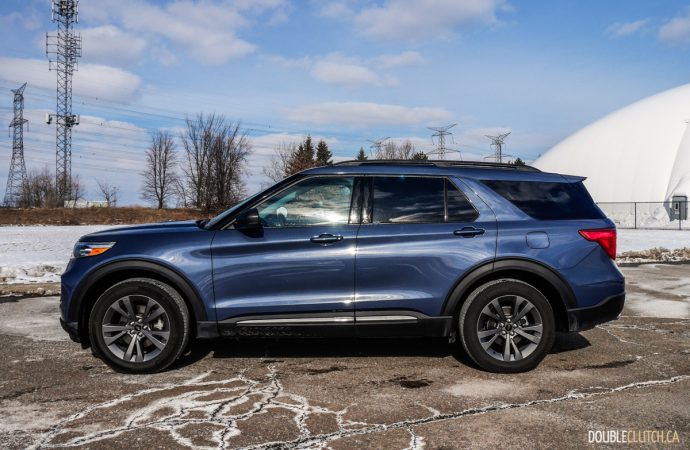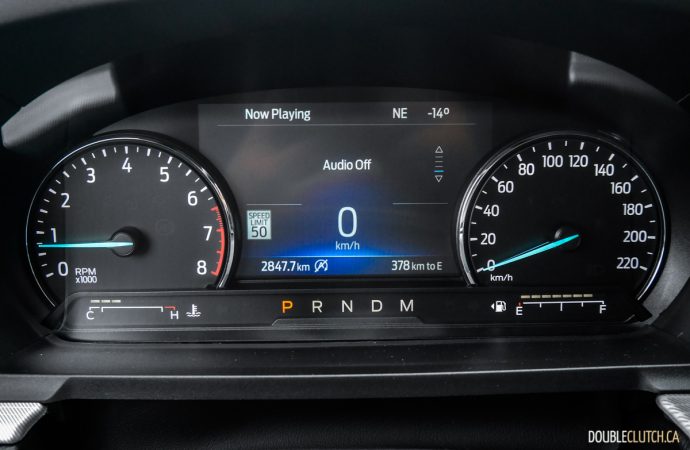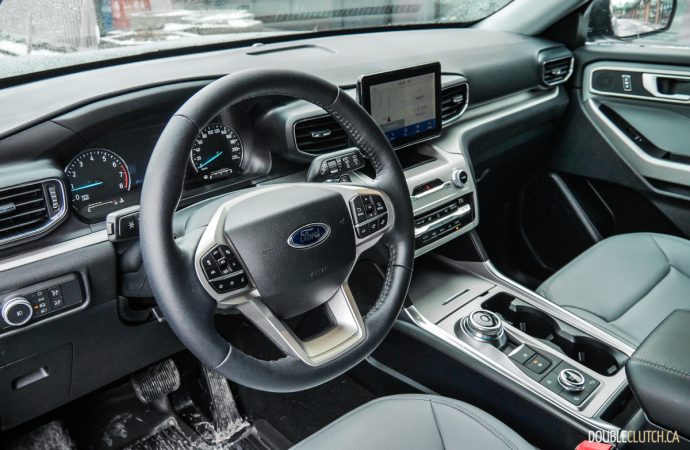The Ford Explorer is one of the earliest mid-size SUVs in the North American market with history dating back to 1991. 30 years later, the sixth-generation has evolved into a sophisticated SUV that emphasizes driving engagement with a rear-wheel drive platform as well as a high-performance Explorer ST variant. For the general public who don’t need 400-horsepower in their family hauler, Ford has given us a boosted four-cylinder or a 3.3-litre hybrid. This week we are handed the keys to the 2021 Ford Explorer XLT with the turbocharged four to find out whether the fun driving dynamics carry over.
The 2.3-litre EcoBoost four-cylinder engine is shared with the Ford Ranger and Mustang, and output is rated at 300-horsepower with 310 lb-ft. of torque. The torquey powerplant is punchy with plenty of low-end power to get going relatively easy, but it runs out of breath quickly on longer sprints. The main issue with the Explorer XLT is not power delivery, but rather its ten-speed automatic transmission. The gearbox is often slow to respond to up and downshifts and spends much of the time seeking the right gear. This leads to a jerky driving experience that gets magnified in an urban setting, and the Explorer XLT is more suitable for highway stretches where it can make use of high gears for a composed cruise.
The Explorer XLT’s has light steering weight but it feels accurate. The chassis is rigid and we observed good balance in the corners. The Explorer’s return to a rear-wheel drive platform yielded positive results in handling, however we were disappointed in brake feel as we often found ourselves looking for the right pedal pressure when rolling to a stop. Drivers can select one of several selectable drive modes including Normal, Eco, Sport, Tow and Haul, and Ice, Snow and Sand through the dial below the rotary shifter, and there is noticeably better powertrain response in Sport mode.
In terms of fuel efficiency, the Explorer XLT is rated at 11.7L/100km in the city and 8.6L/100km on the highway for a combined rating of 10.3L/100km. Our observed fuel economy came in at a higher than expected 12.3L/100km for our city-heavy commute in the winter. The good news is that regular grade gasoline is accepted across the Ford Explorer lineup and the XLT has an 81-litre fuel tank. The Explorer can tow up to 5,600 pounds when equipped with the optional Class III Trailer Tow Package.
The 2021 Explorer is one of the more sportier looking options in its segment right now and we suspect many will be attracted by its good looks alone. The oversized front grille sets the tone and the side profile converges towards the rear to complete its athletic appearance. Our Explorer XLT tester receives a new XLT Sport Appearance Package that features a host of Carbonized Grey painted body parts including the grille bars, hood badge, and wheels, as well as unique lower bodyside cladding insert and skid plate elements and dual chrome exhaust tips.
Moving inside, we observed good interior space in the first two rows. The front seats are comfortable though lateral support could be improved, and we enjoyed the second row’s head and legroom with the captain’s chairs. The third row is best reserved for small children and is on par with most mainstream crossovers in its segment. There is extra sunlight afforded by the optional Twin Panel Moonroof which gave the cabin an airy feel, however we noted a higher than normal increase in wind noise when the moonroof sunshade is open. Cargo space is rated at 515 litres behind the third row and opens up to a generous 1,356 litres once the third row gets folded.
Infotainment is delivered using the standard 6.5-inch LCD touchscreen which houses Ford’s SYNC3 system. The SYNC3 system remains one of the more intuitive systems to use but buyers who likes the techy things will prefer the high-definition 10.1-inch LCE portrait touchscreen with swipe and pinch-to-zoom capability and the Bang & Olufsen premium audio system found in the upper trim levels. Android Auto and Apple CarPlay integration is supported on all trims.
Standard safety equipment includes Auto High-Beam, Lane Keeping Alert and Assist, and Reverse Sensing systems. Buyers are recommended to choose the optional Ford Co-Pilot360 Assist package for a nominal $1,000 extra, which includes Intelligent Adaptive Cruise Control, Lane Centering, Speed Sign Recognition, Evasive Steering Assist, and Voice-Activated Touchscreen Navigation systems.
The 2021 Ford Explorer XLT starts at $45,549 which is similar to several popular three-row crossovers such as the Honda Pilot and the Toyota Highlander, and is a bit more than the base Chevrolet Traverse. It is worth noting that the Explorer’s main competition is front-wheel drive based and the Explorer’s platform might be a good enough selling point on its own.
Our tester came equipped with options such as the XLT Sport Appearance Package ($2,000), Equipment Group 202A with the Remote Start system and the power-adjustable passenger seat ($1,500), Twin Panel Moonroof ($1,750), Ford Co-Pilot360 Assist ($1,000), Class III Trailer Tow Package ($600), Infinite Blue Metallic paint job ($450), and other small accessories bringing the as-tested total to $53,199.
With a handsome appearance, punchy turbocharged engine, and a standard rear-wheel drive-based platform, the 2021 Ford Explorer XLT has good fundamentals to be a sporty family hauler. Unfortunately, it falls short of becoming that because of its sluggish transmission and brake feel and we much prefer the performance-oriented Explorer ST for those who prefer sporty driving dynamics with one major caveat being that they will likely be spending over $60,000 when similarly equipped.






